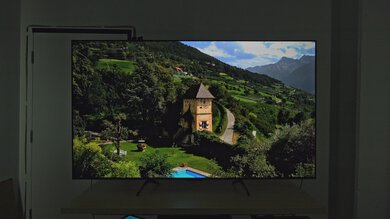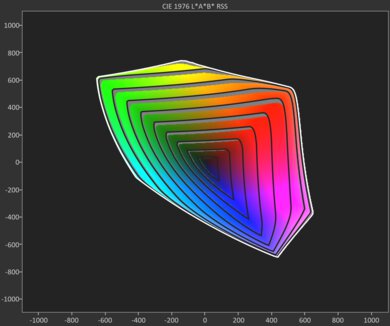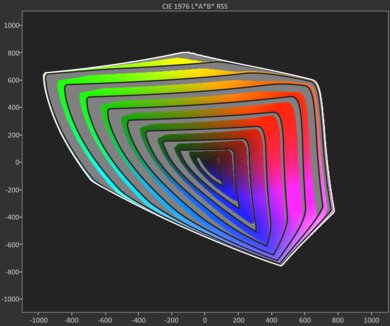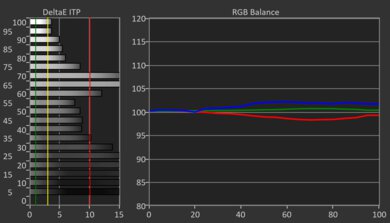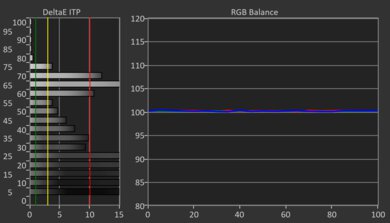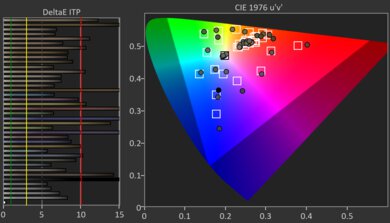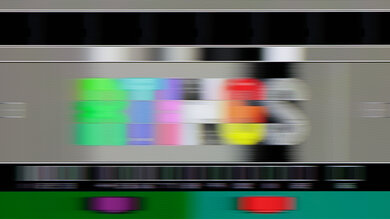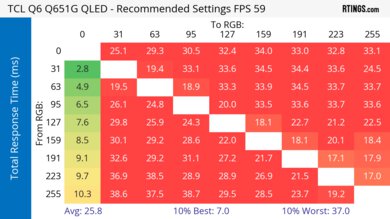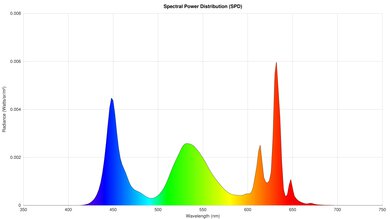The TCL Q6/Q651G QLED is an entry-level TV released in 2024 and replaces the 2023 TCL Q6/Q650G QLED. It sits below the TCL QM7/QM751G QLED and the TCL QM8/QM851G QLED. It's a pretty basic 60Hz TV and doesn't have features like local dimming and HDMI 2.1 bandwidth, but it does support up to 1440p @ 120Hz with VRR using TCL's Game Accelerator 120 feature. It still has some other features like DTS audio support and Dolby Vision. The TV runs version 12 of the popular Google TV smart interface, so it also has smart features like voice control and is loaded with a ton of streaming apps. The TV has a built-in 30W 2.0 channel speaker system. We bought and tested the 75-inch model, but it's available in seven sizes total: 43, 50, 55, 65, 75, 85, and 98-inches.
Our Verdict
The TCL Q6 is sub-par for mixed usage. It's inadequate for a dark room since it has poor black levels. It's also not a good choice when you turn all of your lights on during the day since its SDR brightness is unremarkable, and it struggles with reflections caused by glare. The TV is at its best in a moderately lit environment. Colors are okay overall, but since it lacks local dimming and doesn't get very bright, it struggles with showing both dark and bright colors, which limits the vibrancy of colors in most content. If you're looking for a cheap gaming TV, it's not a terrible choice thanks to its ability to do up to 1440p @ 120Hz with VRR. Unfortunately, its awfully slow pixel transitions mean motion is blurry when gaming, which is a huge drawback. Its viewing angle is mediocre, so it's not a good option for wide seating arrangements.
- 1080p and 1440p @ 120Hz with VRR.
No visible stutter in low frame rate content.
Unremarkable SDR brightness means it's only suitable for moderately lit rooms.
Inadequate HDR brightness leads to a lackluster experience.
- No local dimming to improve contrast.
Does a poor job reducing the intensity of reflections.
The TCL Q6 is inadequate for a home theater. It doesn't have a local dimming feature to boost contrast, so it has poor black levels. It also struggles to show both dark and light colors, so colors don't pop the way they should, and there's some banding in gradients. Unfortunately, the TV's HDR brightness is inadequate for an impactful HDR experience. Furthermore, colors and brightness in HDR content are inaccurate. Unfortunately, it does a sub-par job of upscaling, so low-resolution content looks soft. It also does a mediocre job of reducing artifacts in low-bitrate content. Thankfully, there's no noticeable stutter in 24 fps content thanks to its slow response time.
Great SDR pre-calibration accuracy.
No visible stutter in low frame rate content.
Inadequate HDR brightness leads to a lackluster experience.
Disappointing PQ EOTF tracking leads to an overly dim image in HDR.
Mediocre low-quality content smoothing and sub-par upscaling.
- No local dimming to improve contrast.
The TCL Q6 is mediocre for a bright room. It has unremarkable SDR, so it's not bright enough for a well-lit room and is best suited for a moderately lit environment. It really struggles with reducing the intensity of direct reflections, so it's best to avoid placing a lamp or other light sources opposite the screen. Fortunately, blacks don't raise very much at all, and colors don't lose much saturation in a bright room, so you don't have to worry about losing too much image quality when you turn your lights on.
Blacks stay deep and colors barely lose saturation in a bright room.
Unremarkable SDR brightness means it's only suitable for moderately lit rooms.
Does a poor job reducing the intensity of reflections.
The TCL Q6 is mediocre for sports. It's not suitable for bright rooms, since its SDR brightness is unremarkable, so it's best suited for a moderately lit room. It's also best to avoid placing light sources opposite the screen since it struggles with direct reflections. Its gray uniformity is middling, and there's some apparent dirty screen effect when watching sports like hockey. Unfortunately, the TV's upscaling is sub-par, so low-resolution streams and broadcasts look soft. Additionally, its low-quality content smoothing doesn't eliminate artifacts from heavily compressed feeds. Fast-moving players and objects have noticeable trails of blur behind them, so it's not great for sports like racing. You do get adequate colors, and they're accurate in SDR, so your favorite teams' jersey looks lifelike. Finally, the TV has a mediocre viewing angle, so although the image holds up from a slight angle, it's still not a good option for wide seating arrangements.
Great SDR pre-calibration accuracy.
Noticeable dirty screen effect towards the center of the screen.
Unremarkable SDR brightness means it's only suitable for moderately lit rooms.
Mediocre low-quality content smoothing and sub-par upscaling.
Awfully slow pixel transitions leads to blurry motion.
Does a poor job reducing the intensity of reflections.
The TCL Q6 is inadequate for gaming. It has bad black levels, so the image looks washed out any time bright elements are also on screen. Its HDR brightness is also inadequate for highlights to really stand out, so HDR games are lackluster. Colors look okay, but the TV struggles with dark and bright shades, so games that make good use of color aren't as vibrant as they should be. The TV doesn't have HDMI 2.1 bandwidth, but it does support up to 1440p @ 120Hz with VRR, which is good for gamers on a budget. You also get low input lag for a responsive feel. However, the TV's pixel transitions are awfully slow, so motion is blurry and really lacks clarity.
- 1080p and 1440p @ 120Hz with VRR.
Low input lag for a responsive feel.
Inadequate HDR brightness leads to a lackluster experience.
Awfully slow pixel transitions leads to blurry motion.
- No local dimming to improve contrast.
The TCL Q6 has poor brightness overall. It's not bright enough in SDR to fight glare in well-lit rooms, so it's best suited for dimly lit environments. Its HDR brightness is inadequate, so highlights in HDR content don't stand out much at all.
Unremarkable SDR brightness means it's only suitable for moderately lit rooms.
Inadequate HDR brightness leads to a lackluster experience.
The TCL Q6 has poor black levels. It doesn't have local dimming, so there's no blooming around highlights, but the entire image looks washed out anytime highlights are on screen since it has a low contrast ratio. Fortunately, it does have outstanding black uniformity.
Outstanding black uniformity.
- No local dimming to improve contrast.
The TCL Q6 has okay colors overall. It doesn't display dark saturated colors in HDR due to its limited contrast ratio, and its poor brightness holds back its ability to display bright colors too. It's a bit better in SDR, but it struggles to display light colors, especially in the widest BT.2020 color space. Color accuracy is great in SDR, so colors look the way they should. However, it has sub-par accuracy in HDR, so this isn't a TV to buy if you care about accuracy, especially since calibrating it doesn't help much at all.
Great SDR pre-calibration accuracy.
Note: We're in the process of improving our tests related to image processing, but this score should give you a general idea of how a TV performs overall with its image processing capabilities.
The TCL Q6 has disappointing processing. Its upscaling is sub-par, so low-resolution content lacks clarity. Its low-quality content smoothing is mediocre, meaning there are still artifacts present in heavily compressed content and a loss of detail. The TV's PQ EOTF tracking is disappointing, and HDR content is displayed dimmer than the content creator intends. Finally, its gradient handling is decent, but there's some noticeable banding in dark greens and reds and very apparent banding in dark grays.
Disappointing PQ EOTF tracking leads to an overly dim image in HDR.
Mediocre low-quality content smoothing and sub-par upscaling.
The TCL Q6 has poor responsiveness in Game Mode. It doesn't have HDMI 2.1 bandwidth, but it does support up to 1440p @ 120Hz with VRR, which is a good feature for those on a tight budget. Its input lag is low, so you get a responsive feel while gaming. Unfortunately, the TV has awfully slow pixel transitions, so motion is blurry and lacks clarity, which is a major drawback for the TV's gaming performance.
- 1080p and 1440p @ 120Hz with VRR.
Low input lag for a responsive feel.
Awfully slow pixel transitions leads to blurry motion.
We're in the process of fixing the way we evaluate a TV's overall motion handling. This section is currently broken, and the score isn't indicative of how well a TV handles motion overall.
Performance Usages
Changelog
- Updated May 08, 2025: Converted to Test Bench 2.0.1. We did this to fix an issue with our scoring in the Supported Resolutions section, since TVs with a refresh rate higher than 144Hz were being penalized for not supporting 144Hz.
-
Updated Apr 11, 2025:
We wrote text for the new tests and rewrote text throughout the review after updating pre-existing tests and scores for Test Bench 2.0.
- Updated Apr 11, 2025: We converted the review to Test Bench 2.0. With this new methodology, we've added new tests to expand the scope of our testing, adjusted our scoring to better align with current market conditions, and added performance usages that group related tests together to give more insight into specific aspects of a TV's performance. You can find a full list of changes in the TV 2.0 changelog.
-
Updated Jan 10, 2025:
Added a link to our new Best Google TVs recommendation article in the Compared To Other TVs section of this review.
Check Price
Differences Between Sizes And Variants
We bought and tested the 75-inch TCL Q6/Q651G QLED, and these results are mostly valid for the 43, 50, 55, and 65-inch models. The 85- and 98-inch models use a 120Hz panel, so our results aren't valid for those, although most should be similar. Note that the smaller sizes don't have TCL's Game Accelerator 120 feature, which allows you to drop your resolution in favor of a higher frame rate. The larger sizes have TCL's Game Accelerator 240 feature instead.
| Size | Model | Refresh Rate | Game Accelerator |
|---|---|---|---|
| 43" | TCL 43Q651G | 60Hz | No |
| 50" | TCL 50Q651G | 60Hz | No |
| 55" | TCL 55Q651G | 60Hz | 120 |
| 65" | TCL 65Q651G | 60Hz | 120 |
| 75" | TCL 75Q651G | 60Hz | 120 |
| 85" | TCL 85Q651G | 120Hz | 240 |
| 98" | TCL 98Q651G | 120Hz | 240 |
Our unit was manufactured in February 2024.
Popular TV Comparisons
The TCL Q6/Q651G QLED is a sub-par TV, and it's nothing special in terms of overall picture quality. It's similar to a TV like the Hisense U6/U6N, but that TV has a local dimming feature that improves its contrast and increases its black levels, which makes it look much better than the TCL in a dark room. The U6N is also brighter overall, so it's more well-suited for use in a room with the lights on and delivers a more impactful HDR experience. Even though the TCL can output 1080p and 1440p @ 120Hz with VRR using TCL's Game Accelerator 120 feature, its awfully slow pixel transitions really hold back its gaming performance. If you want a much better gaming model with superior picture quality from TCL and don't mind spending more, consider the TCL QM7/QM751G QLED.
For more options, check out our recommendations for the best Google TVs, the best QLED TVs, and the best gaming TVs.
The TCL S551G and the TCL Q651G are similar overall, but the Q6 is better, mostly due to it being the brighter model. The Q6 displays brighter highlights in HDR content, so it delivers a more impactful HDR experience, even though it's still not great. The Q6 also has the better SDR brightness, meaning it fights a bit more glare in a room with the lights on. Regarding color accuracy, the Q6 has better SDR pre-calibration results, so it doesn't require calibration if you care about accurate colors.
The TCL Q750G is better than the TCL Q651G. The Q750G has a local dimming feature that drastically increases its contrast ratio, so it displays much deeper blacks. The Q750G is much brighter overall, meaning it overcomes more glare in a bright room and displays brighter highlights in HDR content. Colors are more vibrant on the Q750G, and it has better image processing as well. Regarding gaming, the Q750G has HDMI 2.1 bandwidth for up to 4k @ 144Hz gaming and has a faster response time, so it's fully compatible with modern consoles.
The TCL QM6K is significantly better than the TCL Q651G. The newer QM6K is brighter, it has better contrast, and it has a full array local dimming feature, all of which contribute to much better picture quality overall. The QM6K also has better gaming features, with a higher maximum refresh rate at lower resolutions and a wider VRR range with 4k signals. The biggest difference with VRR is that the refresh rate range is wide enough at 4k to allow it to work with Low Framerate Compensation, which keeps the image tear-free even when your framerate drops a bit.
The TCL QM5K is a lot better than the TCL Q651G. The QM5K is brighter in both SDR and HDR, so it can handle more glare in a bright room, and HDR stands out a bit better. Unlike the Q651G, the QM5K features a Mini LED local dimming feature. Even though it's not perfect, it still delivers much deeper, more uniform blacks, and it looks better in a dark room.

We buy and test dozens of TVs yearly, taking an objective, data-driven approach to deliver results you can trust. Our testing process is complex, with hundreds of individual tests that take over a week to complete. Most of our tests are done with specially designed test patterns that mimic real content, but we also use the same sources you have at home to ensure our results match the real-world experience. We use two main tools for our testing: a Colorimetry Research CR-100 colorimeter and a CR-250 spectroradiometer.
Test Results

The TCL Q65 has inadequate HDR brightness. Some highlights stand out a bit in darker scenes, but the TV's HDR brightness isn't good enough to display brighter highlights with impact.
These measurements are after calibrating the HDR white point with the following settings:
- HDR Picture Mode: Movie
- Brightness: 100
- Contrast: 100
- Gamma: 2.2
- Micro Contrast: Off
- Color Temperature: Warm -5
- Dynamic Tone Mapping: Off
The TV has a bug that prevents the 'Dynamic Tone Mapping' settings to apply. To fix this you must toggle the setting on/off.
Results with Dynamic Tone Mapping set to 'Detail Priority':
- Hallway Lights: 333 cd/m²
- Yellow Skyscraper: 233 cd/m²
- Landscape Pool: 122 cd/m²
Results with Dynamic Tone Mapping set to 'Balance':
- Hallway Lights: 348 cd/m²
- Yellow Skyscraper: 216 cd/m²
- Landscape Pool: 140 cd/m²
Results with Dynamic Tone Mapping set to 'Brightness Priority':
- Hallway Lights: 357 cd/m²
- Yellow Skyscraper: 218 cd/m²
- Landscape Pool: 163 cd/m²
There's no noticeable difference in HDR brightness when the TV is set to Game Mode.
These measurements are after calibrating the HDR white point with the following settings:
- HDR Picture Mode: Game
- Game Master: On
- Brightness: 100
- Contrast: 100
- Gamma: 2.2
- Micro Contrast: Off
- Color Temperature: Warm -5
- Dynamic Tone Mapping: Off
The TV has unremarkable SDR brightness, and it's not bright enough to overcome glare in bright rooms. It's better suited for a moderately lit room.
These measurements are after calibration with the following settings:
- Picture Mode: Movie
- Brightness: 100
- Contrast: 100
- Black Level: 50
- Dynamic Contrast: Off
- Black Stretch: Off
- Dynamic Brightness: Off
- Micro Contrast: Off
- Gamma: 2.2
The TCL Q65 has poor contrast. Its native contrast ratio is good enough that blacks are somewhat deep during purely dark scenes, but since it lacks local dimming, blacks become raised and grayish when brighter highlights are also on screen. For a similar TV with slightly better contrast, consider the Hisense QD6/QD65NF QLED.
This TV doesn't have a local dimming feature, so it doesn't adjust the backlight of individual areas to brighten up highlights without impacting the rest of the image. This means that there are no distracting flickers or brightness changes as bright highlights move across the screen.
The TV has just okay SDR color volume. Its coverage of the DCI-P3 color space is decent enough, but the TV does struggle to display some lighter greens, yellows, and reds. It coverage of the wider BT.2020 color space is sub-par, and the TV struggles with colors across the board.
| Volume ΔE³ | DCI-P3 Coverage |
BT.2020 Coverage |
|---|---|---|
| L10 | 91.48% | 65.83% |
| L20 | 91.25% | 64.59% |
| L30 | 90.34% | 63.66% |
| L40 | 88.47% | 64.00% |
| L50 | 86.48% | 63.62% |
| L60 | 83.53% | 60.37% |
| L70 | 79.06% | 50.95% |
| L80 | 77.71% | 47.91% |
| L90 | 77.44% | 47.89% |
| L100 | 82.31% | 57.55% |
| Total | 83.01% | 56.48% |
The TV has mediocre HDR color volume, but it doesn't do a very good job of displaying dark saturated colors due to its limited contrast. It also doesn't display colors very brightly.
The TV has great pre-calibration SDR accuracy. Its white balance is satisfactory, but there's too much red in bright grays and not enough green in most shades of gray. Fortunately, the TV's color temperature is almost exactly at 6500K. Its gamma is close to 2.2, but most scenes are displayed too dark, and bright scenes are too bright. Color accuracy is excellent overall, but there are some inaccuracies with whites, blues, and reds.
The TV has remarkable SDR accuracy after calibration, but it's a bit difficult to calibrate since certain adjustments affect areas they shouldn't. Still, the white balance is now outstanding, and the color temperature is essentially perfect. Gamma is now closer to 2.2, but bright scenes are still too bright. Color accuracy is better now, and whites are fixed, but vibrant reds, blues, and magentas are a bit inaccurate.
See our full calibration settings.
The TV has sub-par HDR accuracy before calibration. There's way too much blue and not enough red in most shades of gray, which makes the TV's color temperature drastically cooler than 6500K. Colors still have decent accuracy, but there are mapping errors throughout, and most colors are undersaturated.
The TV has decent HDR color accuracy after calibration. Its white balance is improved now, although it's not perfect. However, its color temperature is now much closer to 6500K, albeit still a bit too cool. Color accuracy hasn't improved much, and most colors are off the mark and undersaturated.
The TCL Q651G QLED has disappointing PQ EOTF tracking. Blacks and near blacks are displayed brighter than intended, but everything else is displayed dimmer than intended. There's a gradual roll-off near the TV's peak brightness to maintain detail in highlights that are brighter than what the TV is capable of.
The TV does a sub-par job at upscaling low-resolution content like DVDs or lower-resolution streams. Details are too soft, and finer details are incredibly hard to make out. If you're watching a lot of low-resolution content, consider the better-performing TCL NXTVISION.
Sharpness processing was calibrated with no over-sharpening for low-resolution content with the following settings:
- Sharpness: 20
The TV has decent HDR gradient handling. There's very apparent banding in dark grays, while dark reds and dark greens have noticeable banding. All other colors have minimal banding.
This TV has low input lag when set to Game Mode with 'Game Master' turned on, which ensures a responsive gaming experience.
The TCL Q651G supports all common resolutions up to 4k @ 60Hz. It displays chroma 4:4:4 properly when set to Game Mode and PC.
The TV supports all three types of variable refresh rate (VRR) technology to reduce screen tearing. Its VRR range is very narrow in 4k, but when running in 1080p and 1440p @ 120Hz, the VRR range is much wider.
The TV has awful pixel transitions at its maximum refresh rate of 60Hz while in 4k. Pixels change RGB values at an incredibly slow speed, which leads to very noticeable blur behind motion. There's also persistence blur due to the nature of a 60Hz refresh rate.
The TV doesn't support a 120Hz refresh rate at the panel's native 4k resolution.
The TV has awful pixel transitions at its maximum refresh rate of 60Hz while in 4k. Pixels change RGB values at an incredibly slow speed, which leads to very noticeable blur behind motion. There's also persistence blur due to the nature of a 60Hz refresh rate.
The TV can't take full advantage of the PS5, as it can't do 4k @ 120Hz. However, it can do 1080p and 1440p @ 120Hz with resolution halving. Unlike on the Xbox consoles, the TV has no issues playing HDR games at 120Hz on the PS5.
It also supports VRR and Auto Low Latency Mode (ALLM), so the TV automatically switches to Game Mode when it detects the console.
The TV can't take full advantage of the Xbox Series X or S, as it can't do 4k @ 120Hz. However, it can do 1080p and 1440p @ 120Hz with resolution halving. Note that when launching a Dolby Vision or HDR game at these resolutions, the console automatically sets itself to 4k @ 60Hz, as the Xbox only supports HDR with 4k content. To game in 1080p and 1440p @ 120Hz, you must turn off HDR.
The TV also supports VRR and Auto Low Latency Mode (ALLM), so the TV automatically switches to Game Mode when it detects the console.
Due to the TV's slow response time, there's barely any stutter when watching movies or TV shows, and it's not noticeable.
The TV gives a judder-free experience from any source when the Natural Cinema setting is enabled.
The TCL Q6 uses pulse width modulation (PWM) to dim its backlight, and it flickers at 150Hz, which is low enough to be noticeable by users who are sensitive to it, especially as it doesn't flicker in time with the TV's refresh rate. Fortunately, the TV is flicker-free at these brightness levels and picture modes:
- Movie/PC/Vivid/Sports/Game, with brightness levels 29-100
- Low Power, with brightness levels 34-100
- Smart HDR, always flicker-free
The TV doesn't have an optional backlight strobing feature, commonly known as black frame insertion (BFI), to help reduce persistence blur.
The TV has an optional motion interpolation feature to improve the clarity of motion, but it doesn't work very well. It does an okay job of smoothing out slower panning shots, but there are still some noticeable artifacts present. The TV really struggles with fast-moving scenes, and there are distracting artifacts around fast-moving objects.
The TV has inadequate direct reflection handling. It barely reduces the intensity of light sources placed opposite the screen, so your lamp or window is very visible on screen.
Fortunately, blacks remain deep and punchy in a bright room, so you don't have to look at an overly washed out image when you turn your lights on.
The TCL Q6 does a disappointing job with total reflected light. Direct reflections are very distracting, but it also struggles to reduce the intensity from indirect light sources; if you're in a very bright room, your room is reflected on screen during darker scenes.
The TV has alright perceived color volume in a bright room. Its colors are only okay to begin with, so even though they don't lose very much saturation in a bright room, they're still not very vibrant.
The TCL Q6 has a mediocre viewing angle, so it's not suitable for a very wide seating arrangement. As you move off-center, there's significant gamma shifting, black level raise, brightness loss, and colors look increasingly washed out as you move further away to the sides.
The TV's gray uniformity is middling. The corners of the screen are darker than the rest, and there's noticeable dirty screen effect towards the center. On a very dark or near-black screen, its uniformity is decent, but the edges are slightly lighter than the rest of the screen.
The TV uses a BGR (Blue-Green-Red) subpixel layout instead of the traditional RGB layout. This doesn't cause any issues for video or gaming content, but it can be a problem for PC monitor use as it impacts the text clarity, although not everyone will notice this.
The TV uses a KSF phosphor coating to produce red light, and it has good color purity, helping it display a wide color gamut.
This TV is limited to HDMI 2.0 bandwidth on its three HDMI ports. Fortunately, it supports HDR10+ and Dolby Vision. The tuner is limited to ATSC 1.0, so you can't stream 4k content over the air.
The TCL Q65 supports eARC, which lets you pass high-quality, uncompressed audio to a compatible receiver or soundbar through an HDMI cable. It supports all major audio formats, so you don't have to worry about compatibility with external sources.
The TCL 65Q651G looks the same from the front as 2023's TCL Q6/Q650G QLED. It has thin black bezels on three sides and a slightly thicker bottom bezel that's silver. It looks pretty good overall. There's branding near the top corner on the right bezel that uses reflective writing that is distracting in a well-lit room.
The TV has a set of plastic feet, which you can place at two distinct positions. The first position, pictured above, sets the feet in a wider position and has a footprint of 53.4" x 14". The narrow position brings the feet closer together, which works well for smaller tables. In this position, the feet have a footprint of 28.6" x 14". The screen sits about 3.58" from the table, so most soundbars fit underneath without blocking the screen. In the narrow position, the protruding feet get in the way of putting a soundbar directly in front. Note that the 98-inch model (TCL 98Q651G) has different feet than the rest of the sizes.
The back of the TV is made of metal and plastic. The power cable comes out of the left side of the TV, and the inputs are housed in a recessed cutout on the right side when facing the front. The cutout is fairly shallow, so the inputs are pretty easy to access if you have it wall-mounted. Unfortunately, it doesn't come with clips and has no form of cable management.
The TCL Q6 QLED has decent build quality. Most of the TV is made of plastic, but the metal borders give it a fairly solid feel. There are no issues with quality control. The metal legs hold the TV well, so there are no issues with stability. There's some flexing on the back, but it's not unusual and is nothing to worry about.
The TCL Q651G comes with the same remote as last year's TCL Q6/Q650G QLED. You can use the built-in microphone to switch inputs, change apps, search within apps, and ask for the weather and time. Unfortunately, you can't change the settings on the TV using the voice controls.
The TCL Q6 has an adequate frequency response. Like most TVs, it doesn't produce much bass, but it does get quite loud. The sound profile is balanced enough that dialogue is clear at most volume levels, but it does become more unbalanced near its maximum volume.






